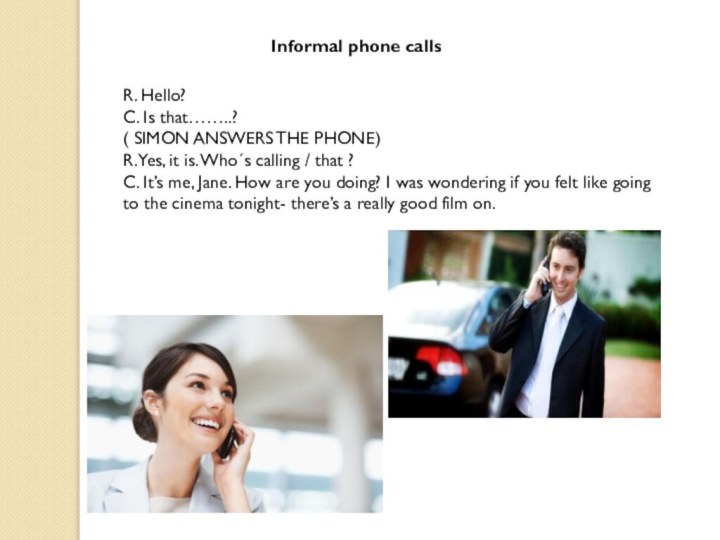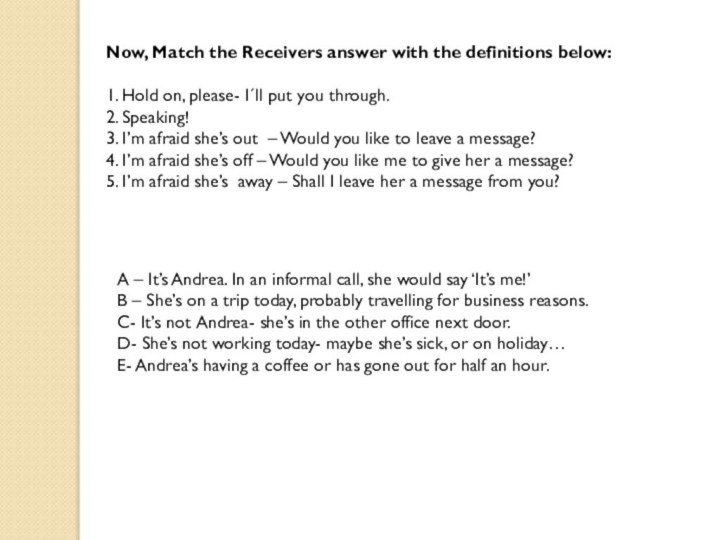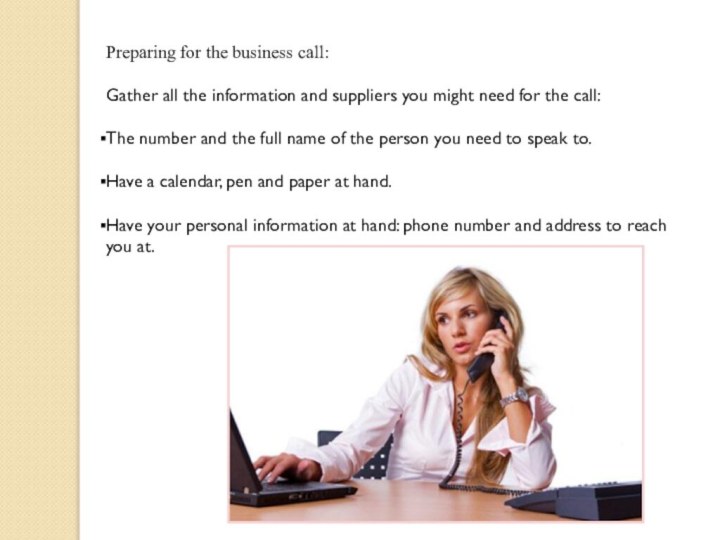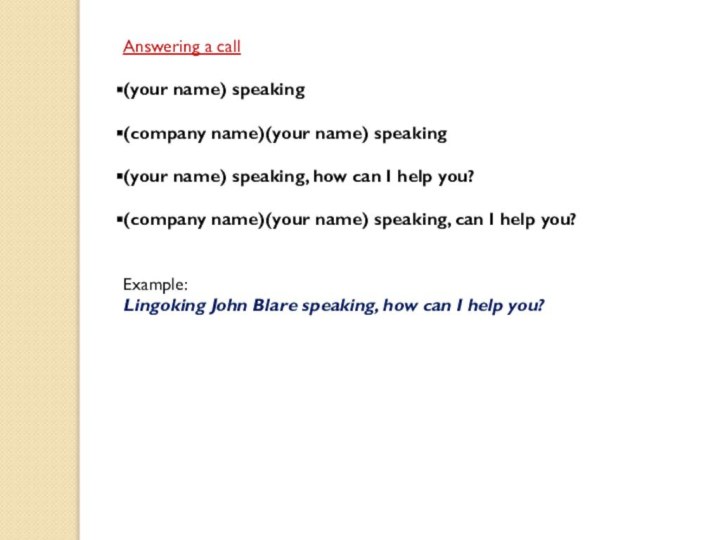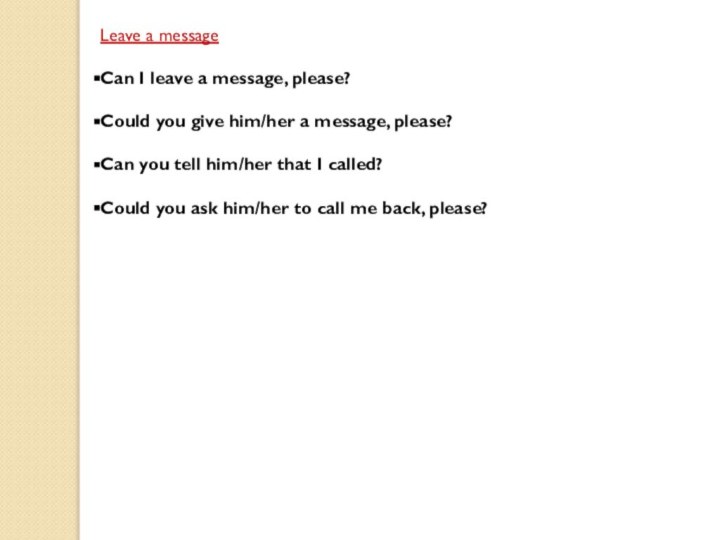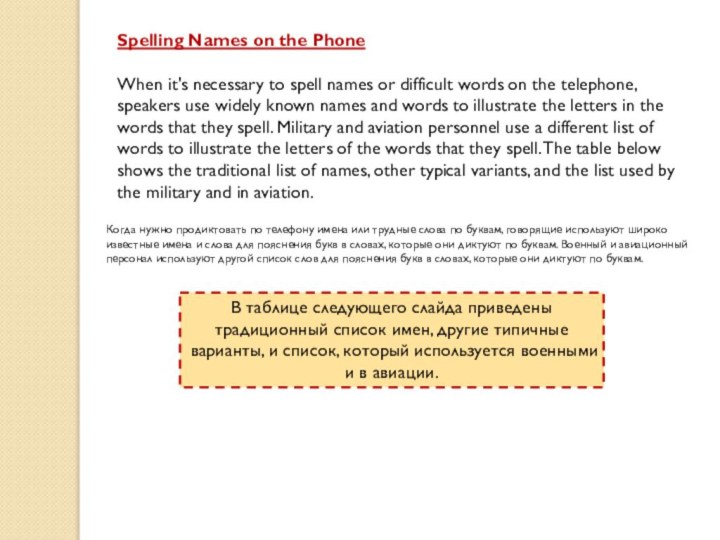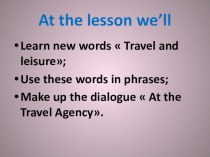Слайд 2
Phone = Call = Ring = Give somebody
a ring =
Give somebody a bell
Jane is phoning
his friend Simon.
She wants to invite him to the cinema.
C = Caller, the person who is phoning (Jane)
R = Receiver, the person who answers the call (Simon)
Слайд 3
R. Hello?
C. Is that……..?
( SIMON ANSWERS THE PHONE)
R. Yes,
it is. Who´s calling / that ?
C. It’s me,
Jane. How are you doing? I was wondering if you felt like going to the cinema tonight- there’s a really good film on.
Informal phone calls
Слайд 4
Formal phone calls
Now you want to speak to
Andrea, who works in an Estate Agent’s:
R. Riches Estate
Agents. Can I help you?
C. Could I speak to …….. please?
Слайд 5
Now, Match the Receivers answer with the definitions
below:
1. Hold on, please- I´ll put you through.
2. Speaking!
3.
I’m afraid she’s out – Would you like to leave a message?
4. I’m afraid she’s off – Would you like me to give her a message?
5. I’m afraid she’s away – Shall I leave her a message from you?
A – It’s Andrea. In an informal call, she would say ‘It’s me!’
B – She’s on a trip today, probably travelling for business reasons.
C- It’s not Andrea- she’s in the other office next door.
D- She’s not working today- maybe she’s sick, or on holiday…
E- Andrea’s having a coffee or has gone out for half an hour.
Слайд 7
How to make a business phone call in
English?
Most of the people find it difficult to make
business phone calls in a
foreign language. Therefore, in order to make an effective phone
call, you must prepare ahead. This will save you time and
frustration. Remember that your voice at the end of the line will be
the first impression of you. Thus, you need to conduct yourself in a
professional manner when making business phone calls.
Слайд 8
Preparing for the business call:
Gather all the information
and suppliers you might need for the call:
The number
and the full name of the person you need to speak to.
Have a calendar, pen and paper at hand.
Have your personal information at hand: phone number and address to reach you at.
Слайд 9
Make sure you are in a quiet
and comfortable environment.
This means to turn off the TV,
music devices and any other distractions; children and babies should be out of the room when you are making a business call.
Слайд 10
Think about what you need to accomplish
with this call.
Use notes (‘talking points’) to guide you
through the facts and details you want to mention.
This may be your only chance to get your point across.
Слайд 11
Making the business call:
A business call has three
main stages: introduction,
middle bulk,
an ending summary of the
call.
Introduce yourself or/and remind the person you are calling of your identity at the beginning of the call.
Слайд 12
Express gratitude.
Always thank the potential client for allowing
you a few moments in his/her busy day.
“I
want to thank you for taking my call.
This will only involve a moment of your time
so you can get back to your busy schedule”.
Слайд 13
Make sure that the person you are calling
is fully available to talk.
If not, try to schedule
an appointment for you to call back again.
State the purpose of your call.
Be clear and to the point. Do not allow the conversation to go into meaningless chatter.
Слайд 14
It is important to ask the other person
to repeat what you are saying.
In this way you
will make sure that he/she fully understands what the conversation is about.
Summarise the important points of the conversation and stress on each other’s responsibilities.
End the call in a pleasant manner. Thank once again the other person for his/her time. Set an appointment for another call if it is needed, and wish him/her a good day.
Слайд 15
Telephone phrases in English:
Making a call
Hello/Good morning/Good afternoon
Can
I speak to (name), please?
May I speak to (name),
please?
I would like to speak to (name) please.
I am trying to contact (name)
This is (your name) from (your company’s name) …
I am calling on behalf of Mr/Mrs/Ms (name)
Can I have extension 629, please? (extension is an internal
number at the company)
Example:
Hello, this is John Blare from Lingoking. Can I speak to Mrs Brighten,
please?
Слайд 16
Answering a call
(your name) speaking
(company name)(your name) speaking
(your
name) speaking, how can I help you?
(company name)(your name)
speaking, can I help you?
Example:
Lingoking John Blare speaking, how can I help you?
Слайд 17
Asking for more
Excuse me, who is calling?
Information
I am
sorry, who is speaking?
Where are you calling from?
Are you
sure you have the right number?
Can you please tell me (question)?
Слайд 18
Ask the speaker to wait
Just a moment, please.
Could
you wait for a moment, please?
Could hold on a
second, please?
Can you hold the line, please?
Слайд 19
Connecting someone
Thank you for holding.
I’ll put you through
now.
The line is free now. I’ll put you through.
I’ll
connect you now/I’m connecting you now.
Слайд 20
Telephone problems
The line is very bad. Could you
speak up, please?
Could you repeat that, please?
I’m afraid I
can’t hear you.
I am sorry, I didn’t catch that. Could you repeat that again,
please?
Слайд 21
How to reply when someone is not available.
I’m
afraid (name) is not available at the moment.
I’m afraid
the line is engaged. Could you call back later?
I’m afraid he/she is in a meeting at the moment.
Mr (name) isn’t in. (the office)
Mrs (name) is out at the moment.
I’m sorry, Mr/Mrs (name) is out of the office today.
Слайд 22
Take a message
Would you like to leave a
message?
Could I take a message?
Would like him/her to call
you back?
Should I tell (name) who is calling?
Could you give me your name, please?
What is your number, please?
Слайд 23
Checking information
Could you spell that for me, please?
Can
I just check that again, please?
Could you repeat that,
please?
Слайд 24
Leave a message
Can I leave a message, please?
Could
you give him/her a message, please?
Can you tell him/her
that I called?
Could you ask him/her to call me back, please?
Слайд 25
Things you must keep in mind when making
a business call in English:
It is important to use
the right level of formality.
If you are too formal, then the person might find it difficult to feel comfortable when she/he talks to you.
Then again, if you are too informal, the person could think that you are rude.
It is important to show politeness. Always use please and thank you or thanks very much whenever you ask for, or receive, help or information.
Use words like would, could, may, please, etc. to show politeness. It is alright to use more informal English, such as okay, bye,
no problem, as long as the overall tone of the conversation is polite.
Слайд 26
If you call native speakers in English, you
might find it difficult to understand them.
The business people
tend to speak very quickly on the phone so you will probably need to slow them down:
Immediately ask the person to speak slowly.
Repeat each piece of information, such name or telephone number or any
important data, as the person speaks. Then you automatically slow the speaker down.
Do not say you have understood the person if you have not. Ask him/her to repeat until you have understood.
Also you can ask the speaker to rephrase it or you can
simply say: “I am sorry, do you mean….(what you have understood)”
Слайд 27
Remember that it is not only important what
you say, but how you say it. You must
speak in a professional and friendly manner and at an appropriate pace.
Слайд 28
Spelling Names on the Phone
When it's necessary to
spell names or difficult words on the telephone, speakers
use widely known names and words to illustrate the letters in the words that they spell. Military and aviation personnel use a different list of words to illustrate the letters of the words that they spell. The table below shows the traditional list of names, other typical variants, and the list used by the military and in aviation.
Когда нужно продиктовать по телефону имена или трудные слова по буквам, говорящие используют широко известные имена и слова для пояснения букв в словах, которые они диктуют по буквам. Военный и авиационный персонал используют другой список слов для пояснения букв в словах, которые они диктуют по буквам.
В таблице следующего слайда приведены традиционный список имен, другие типичные варианты, и список, который используется военными и в авиации.
Слайд 30
Examples
I. _ My name is Alexey Tumanov.
+ How do you spell your last
name, please?
_ That's T as in Thomas, U as in Utah, M as in Mary, A as in Alice,
N as in Nellie, O as in Oscar, V as in Victor. That's Tumanov.
+ How do you spell your first name, please?
_ That's A as in Alice, L as in Lewis, E as in Edward, X as in X-ray,
E as in Edward, Y as in Young. That's Alexey.
II. _ My name is Anastasia Roschina.
+ How do you spell your name, please?
_ That's R as in Robert, O as in Oliver, S as in Samuel,
C as in Charles, H as in Henry, I as in Ida, N as in Nellie,
A as in Alice. That's Roschina.
Слайд 31
III. _ My last name is Krossman, with
a K and double S.
+ Can
you spell the name of your company, please?
_ It's Muzfond. That's M-U-Z-F-O-N-D. [em-yu:-zi:-ef-ou-en-di:]
+ Can you spell it again, please?
_ That's Mary-Union-Zero-Frank-Oliver-Nick-David. Muzfond.
IV. _ What is the name of your company again?
+ It's Tekhmir. That's T as in Tom, E as in Edward, K as in Kate,
H as in Harry, M as in Mike, I as in India, R as in Robert.


